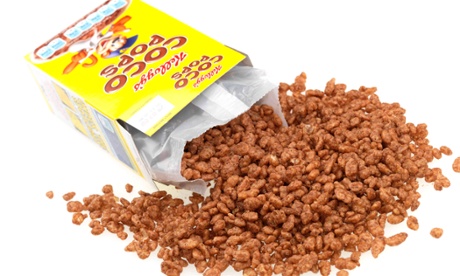Advertising of products such as Coco Pops and Smarties, which is allowed by industry, would fail government criteria

Large food companies have set their standards for what constitutes healthy food so low that they consider products laden with fat, sugar and salt to be healthy and so continue to market them towards children, a Sydney study found.
Researchers from the Cancer Council NSW examined two weeks’ worth of food advertising broadcast between 6am and 9pm in Sydney by channels Seven, Nine and Ten to see how they rated for healthiness.
Food companies can currently use their own nutrition criteria to determine which foods can be marketed towards children and fast food outlets can sign up to a separate voluntary code.
But when assessed under a government-endorsed nutrition criteria, developed by Food Standards Australia New Zealand, the researchers found more than 60% of the 116 food advertisements targeted at children were considered unhealthy.
The study found foods such as Kellogg’s Coco Pops, Arnott’s Tiny Teddies and Nestle Smarties were promoted to children according to the food companies’ own voluntary health standards even though they would fail to be found healthy by the government regulators.
“We also found loopholes in the fast food code,” the council’s nutrition program manager and study author, Clare Hughes, said.
“Currently it only covers advertising of children’s meals, but our study found foods like KFC’s Mint Choc Krusher, and McDonald’s Chicken N’ Cheese Burger which aren’t children’s meals, can still be advertised to children.”
However, a spokesman for the Australian Food and Grocery Council said the research was not useful because the television advertising viewing window used by researchers did not reflect when children were watching programs.
“The research considers advertising during all shows between 6am to 9pm, covering crime programs like Law and Order and movies featuring sex and violence – programs which are hardly targeting children,” he said.
“This not a useful basis for which to consider advertising to children. It is disappointing that the paper did not consider that advertising bans overseas have demonstrated no reduction in childhood obesity.”
Hughes said there was no reason why the standards developed by Food Standards Australia and New Zealand should not be applied to food industry television advertising.
“Their system is the one that has been used to underpin food labelling regulations in Australia that now prevent companies from being able to make health claims such as ‘promotes healthy bones’,” she said.
“We should expect now that it has been applied to food packaging it should also be applied to television advertising to ensure unhealthy foods aren’t being promoted to children in other ways.”
A professor in health policy at Curtin University, Mike Daube, said the study, published in the journal Nutrition and Dietetics, was important, and that the food industry would always fight against strengthened marketing regulations.
“This study meticulously destroys the food industry’s phoney claims around responsible marketing,” Daube, who is also director of the Public Health Advocacy Institute, said.
“The food industry’s regulatory systems are designed to fail – and they fail especially to protect their youngest, most vulnerable consumers.
“In the 21st Century obesity era, their approach is utterly irresponsible – junk regulation for junk food marketing.”
